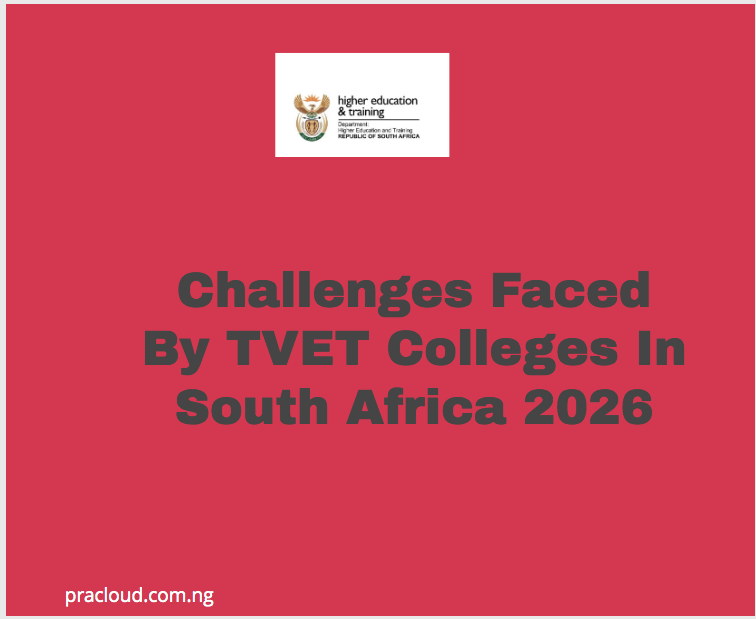Challenges Faced By TVET Colleges In South Africa 2026
Challenges Faced By TVET Colleges In South Africa 2026
Challenges Faced By TVET Colleges In South Africa 2026
In recent years, Technical and Vocational Education and Training (TVET) colleges in South Africa have been seen as key drivers in addressing youth unemployment and bridging the country’s skills gap. As of 2026, the role of these institutions remains as important as ever, yet they continue to face a broad range of challenges that hinder their effectiveness and impact. While government support and policies have improved, many TVET colleges still struggle with issues related to infrastructure, outdated curricula, lack of qualified lecturers, and limited industry partnerships.
One of the most pressing concerns is the misalignment between the training provided and the actual needs of the job market. Many students graduate without the practical experience or relevant skills required by employers, making it difficult for them to find employment. Additionally, there are persistent issues of underfunding, which limit the colleges’ ability to upgrade facilities, invest in new technology, and attract skilled educators.
Another major challenge is the stigma still associated with vocational education in South Africa. Despite being a valuable alternative to university, many young people and their families view TVET colleges as a “second choice,” leading to lower enrolment numbers and a lack of enthusiasm among students. Administrative inefficiencies, accreditation delays, and poor communication between government, colleges, and industry also contribute to a system that is often frustrating for both learners and educators.
Read Also: Biggest TVET Colleges In South Africa
Here are also some challenges and recommendations faced by TVET Colleges
The following challenges are facing TVET Colleges in South Africa:
1. TVET does not respond to the demands of the market and the needs of the industry:
Many of those leading the TVET system look at the industry not as partners but as a source of funds. They have no desire to develop partnerships with the industry beyond funding.
2. TVET does not promote the priorities of the Government, especially its economic policy.
TVET, being part of education for a long time, still sees itself as part of a social policy, not of economic policy, so TVET managers are not even aware of the country’s economic priorities.
3. Most developing countries put less value on TVET than on university or college tertiary education.
Parents and the community as a whole look down on TVET, so bright students often veer away from this, and TVET becomes the dumping ground for those whose academic capacity is not up to the requirements of higher learning.
One high school offering TVET divided the students into the Science group and the TVET group based on average academic performance.
In another school, the division is by the interest of the student, so students who want TVET enroll in Electronics or Automotive Construction. However, very few students opt for TVET, especially among female enrollees. Two or 3 girls in a school year is what TVET gets. This really affects the flow of bright technicians to the industry.
4. Resources for TVET are very limited.
Equipment from previous investments is left idle due to the expensive trading supplies, no capacity to repair the imported equipment, and few knew how to use it. Some of this equipment has already become relics of previous industrial requirements.
Not much contribution from the private sector has come in to support TVET. The private sector would rather spend money to train its own workforce than ask TVET institutions to do so, given the poor quality of the course offerings.
5. Weak participation from other stakeholders.
This largely results from the relevance of TVET programs and the lack of skills of TVET graduates in the industry. If the industry is strongly involved in TVET, chances are its graduates can easily find employment.
6. Lack of industry experience for many TVET teachers.
TVET institutions cannot really hire trainers from the industry as their fees are much higher. Often, TVET institutions have to hire graduates of the Government teacher training institution.
In one country, the graduate of this type of training institution is sent to technical colleges each year regardless of the school’s needs. These new teachers have few technical skills.
7. Lack of motivation for students to invest in TVET education.
Finishing TVET in many countries will not land them high-paying jobs. Whereas, TVET institutions offering courses relevant to the needs of the market are getting students working to support themselves in these courses.
This is true of Computer courses, Accounting, English, and Hotel,l, and Restaurant Management. These courses attract many students because the industry wants them, and many times, they are hired even without finishing the course. Students invest in courses that meet their needs.
Most TVET institutions in developing countries have difficulty attracting students. They have fewer enrollees in their regular programs, but have to turn back students from these more popular courses.
Systematic Instructor/Trainer/Teacher Professional Development
In terms of systematic professional development of instructors, trainers, and teachers, TVET in developing countries has numerous problems. Instructors, trainers, and teachers face challenges in learning how to use new technologies and staying current with teaching approaches in a variety of vocational training programs. When dealing with TVET Quality Assurance as one of the primary objectives for TVET Reform in Developing Countries, this is one of the most significant topics to address.
Encouraging Lifelong Learning and Continuing TVET
In developing countries, developing truly coherent and comprehensive ongoing TVET and lifetime learning methods is a difficulty. Such ideas should be actively encouraged, and actions should be devised at all levels of ongoing TVET and lifelong learning.
Keeping Up with Technological Advancements and Using Appropriate Technology in TVET
There are numerous obstacles to overcome in terms of establishing proper infrastructures and upgrading current materials and training resources. There is a need for appropriate tools and equipment to be used in vocational training and by instructors, trainers, and teachers to keep up with changing times and skills. Applications Open for TVET College
Contact Information
- Visit: 123 Francis Baard Street, Pretoria, South Africa
- Contact Details: 0800 87 2222 | callcentre@dhet.gov.za
For more information, visit the official website of Tvets Colleges
RELATED SEARCH






